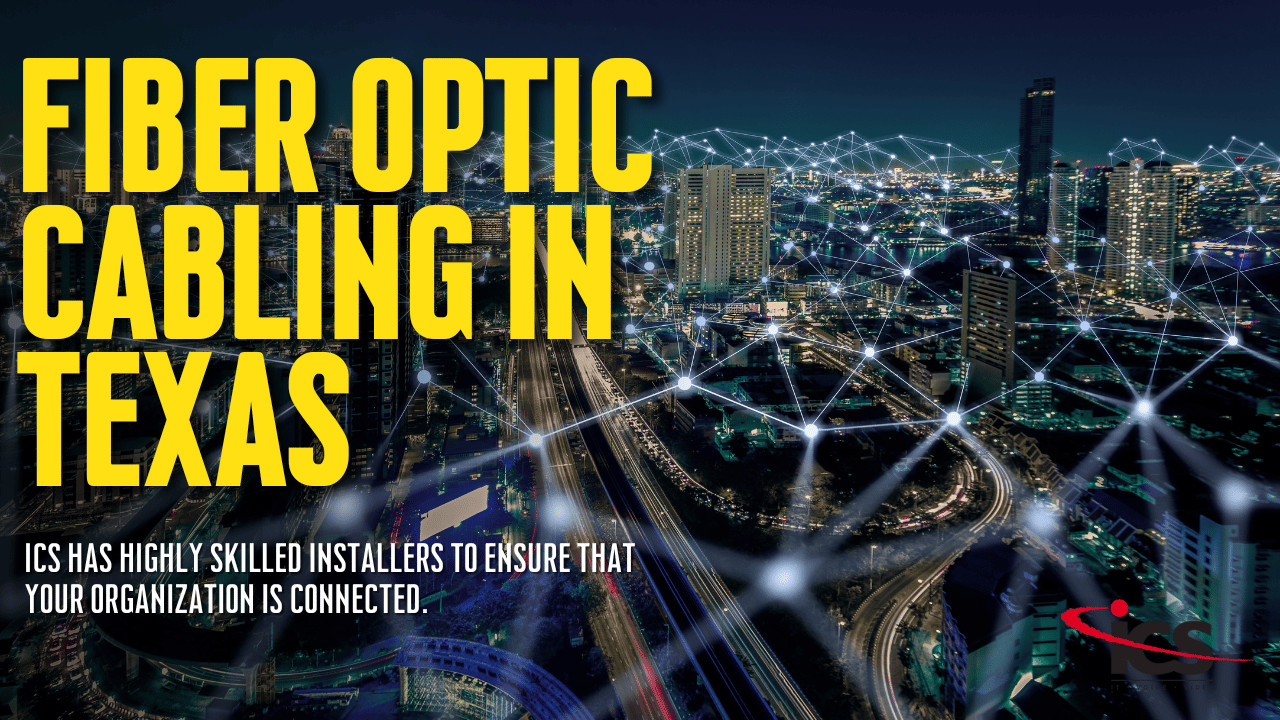Get in touch with us today to find out how can we help you.
A Texas Business Guide To Fiber Optic Cabling
Key Points:
- Fiber optic cabling provides greater bandwidth and greater speed.
- Compared to traditional network cabling, fiber optic cabling is thinner, lighter, and more flexible than copper cabling.
- Fiber optic cabling provides additional security.
Transmission signals used in data networks rely on two primary types of cables. The most common type is traditional copper wire, such as that found in ethernet or coaxial cable. However, fiber optic cabling dramatically utilizes new technology to improve performance and efficiency.

What is Fiber Optic Cable?
A fiber optic cable contains strands of glass fibers, each smaller in diameter than a human hair. When bundled together inside an insulated casing, they become a fiber-optic cable. Copper cables pass low-voltage electrical pulses through the wire, which are converted to binary data and processed by a computer. Fiber optic cabling transmits information as pulses of light, which are then processed.
Fiber optic cabling can transmit more data at significantly faster speeds than other cabling options. Designed for high-performance data networking and telecommunications, fiber optic cabling provides higher bandwidth, enabling data transmission over longer distances. Fiber optic cable is the technology providing homes and businesses around the world with high-speed internet, television services, and telecommunication systems.
Fiber optic cabling can be classified into two types, single mode or multi mode. Single-mode fiber optic cable utilizes an extremely small filament that generally carries a single signal. Multi-mode fiber optics have a filament over five times thicker than single-mode and transmit multiple light rays. Each type is best suited to specific situations, and choosing the best one for your application involves assessing your unique needs.
Benefits of Switching to Fiber Optic Cabling for Texas Organizations
While traditional copper cabling has a long history, fiber optic cabling has proven itself in numerous applications. With fiber optic cabling becoming more accessible for businesses in Texas, it’s become easy to integrate a fiber optic network and improve connectivity. Fiber optic cabling offers several benefits that make it the best solution for many organizations in Texas.
High Bandwidth Levels
The internet is necessary for many organizations, and copper cable has bandwidth limitations that handicap a modern, internet-dependent business. Fiber optic cables have significantly greater bandwidth than copper, enabling them to attain 100-gigabit speeds. In addition, fiber optic cabling requires little power, doesn’t suffer from electrical interference, and resists corrosion.
The time it takes for a data packet to travel from one point to another, known as latency, decreases with fiber optic cable. This low latency gives you faster download and upload times, quicker access to resources, and enables data to be transmitted over longer distances without delays or interruptions.
Faster Speeds
High bandwidth levels mean faster speeds. Slow internet connections waste time and productivity. A fast, efficient, and reliable internet connection is vital to keeping your organization as efficient and productive as possible.
Fiber optic cabling is significantly faster than even the highest quality high-speed copper internet connections. With more and more organizations relying on data transmission, the availability of high bandwidth levels is becoming increasingly vital.
Increased Security
Fiber optic cable provides increased security for your organization’s data. Fiber cables don’t radiate signals, and it is extremely difficult to intercept data transmission without your knowledge. Since the signal travels through a fiber cable as a pulse of light, it must be accessed at the end of the cable or intercepted by cutting the cable. Typically this action would take your network down, and everyone would be quickly aware of the problem.
Greater Flexibility
The reliability of your connectivity is vital to your organization. Communication and connectivity are crucial, as unplanned downtime can bring your business to a halt. Unreliable connectivity adds actual expenses to your organization.
Fiber optic cables are thinner and lighter than copper cables. In addition, they can bend easily and withstand more pull pressure than copper. The flexibility of fiber optic cabling makes them less prone to damage and breakage, and they even resist corrosive elements that can damage typical copper cables.
Fiber optic cables transmit pulses of light rather than electrical currents, so connections are fully-resistant to electromagnetic, lightning, or radio signal interference. Fiber optic networks are not susceptible to inclement weather conditions, which can interfere with or stop data transmission through copper cabling.
Applications For Fiber Optic Installations
Other than extreme situations where installation of the necessary infrastructure is prohibitive, fiber optic cabling is a superior solution for nearly all applications.
Outside Plant or OSP
Outside plant or OSB applications are when fiber optic cable is installed outside the building. For example, the cable may be hung from utility poles or buried in the ground. This type of installation typically involves miles of cable to provide connectivity between major switches or transmitting stations. Most OSP applications use single-mode fiber optic cable because of its ability to maintain signal quality over long distances.
Premises or In-building
Premises cabling is an application where fiber optic cable is installed in a building, such as a home, office, or campus, to provide a local high-speed network. In-building applications are more likely to use multi-mode fiber optic cabling because of the shorter run lengths and lower cost of multi-mode transceivers than installing multiple single-mode transceivers.
Platform
Platform applications are generally small-scale circumstances where fiber optic cable is preferable. These situations include applications where electrical interference could be catastrophic, such as in an airplane. Due to its performance characteristics, fiber optic cabling is the preferred solution in critical applications.
Wiring Operations
Fiber optic cabling is also operationally simple. Unlike copper, optic cabling doesn’t require power boosters, signal repeaters, grounding, or additional cooling. The simple operational requirements help offset additional installation costs associated with fiber-optic networks.
Work With an Expert to Install Your Fiber Optic Network
Fiber optic cable is a technology that requires specialized skills, tools, and knowledge of industry standards. While copper cable has a long history, fiber optic cable demands specific knowledge for routing, splicing, and terminating, making it vital to work with an experienced professional.
At ICS, our professionals are experts at planning, designing, and installing fiber optic networks. We’re also familiar with the permit process in Texas and can help avoid unplanned delays due to paperwork and bureaucracy.
ICS has highly skilled installers to ensure that your organization is connected. Contact us today to learn more about fiber optic cabling and how your organization can benefit.

ICS is a Texas-based 40-year-old technology company specializing in Managed IT, VoIP, Video Conferencing and Video Surveillance solutions for US and International businesses. ICS has over 4000 regional installations and specializes in multi-site businesses between 25 and 2500 employees. ICS’s customers enjoy the experience of ICS’s Total Care program which provides clients flat fee services with obsolescence and growth protection. Whether a customer elects to deploy their IT, Video Conferencing or VoIP in the cloud or on the customer’s premise, ICS can provide a full turn-key solution for our clients under one flat monthly fee.



